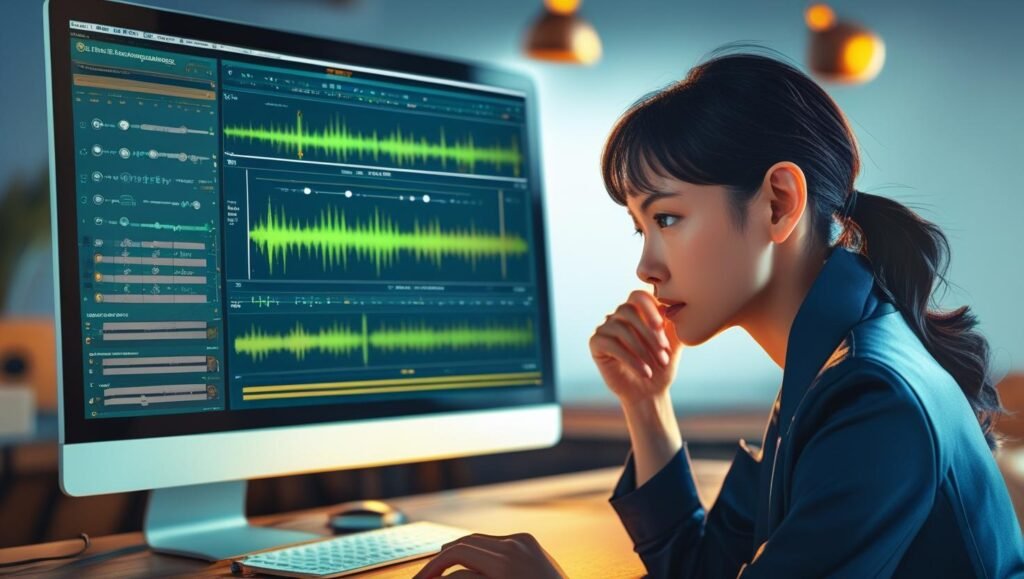From Audio to Sheet Music: The Best AI Music Transcription Tools You Should Know

In a world where music transcends boundaries, capturing the essence of sound and transforming it into notation has never been more accessible. Whether you’re a budding musician, a seasoned composer, or simply someone who loves to explore melodies, AI music transcription tools are revolutionizing the way we interact with music.
Gone are the days of laboriously transcribing every note by ear; today’s technology harnesses sophisticated algorithms to convert audio into sheet music with remarkable accuracy and speed. But with a myriad of options available, which tools truly stand out?
In this article, we’ll delve into the best AI music transcription tools you should know, empowering you to take your musical journey from audio to sheet music smoothly and effortlessly. Get ready to unlock your creative potential and transform your listening experience as we explore the top tools redefining music transcription!
How AI Music Transcription Works
At its core, AI music transcription involves the transformation of audio signals into written musical notation. This intricate process begins with the analysis of an audio file, where sophisticated algorithms deconstruct the sound into its fundamental components, such as pitch, rhythm, and timbre. Machine learning models, often trained on vast datasets of music, then identify and interpret these components to accurately transcribe the audio into sheet music. This technology leverages advancements in signal processing and pattern recognition to achieve a high degree of precision.
One of the key technologies underpinning AI music transcription is deep learning, particularly neural networks. These neural networks are designed to mimic the human brain’s ability to recognize patterns and make predictions. By feeding the network a large number of labeled examples, such as pairs of audio files and their corresponding sheet music, the AI learns to discern the relationships between audio features and musical notation. Over time, the model becomes adept at predicting the correct notes, rhythms, and dynamics for new, unseen audio inputs.
Another crucial aspect of AI music transcription is the preprocessing of audio data. This step involves filtering out noise, normalizing volume levels, and segmenting the audio into manageable chunks. Advanced algorithms then analyze these chunks to detect individual notes and their attributes. The transcription process is iterative, with the AI refining its predictions based on feedback and corrections, much like a human transcriber would. The result is a digital sheet music file that can be edited, printed, or played back using music software.
Benefits of Using AI Music Transcription Tools

The advantages of using AI music transcription tools are manifold, making them an invaluable asset for musicians, composers, and educators alike. One of the most significant benefits is the sheer speed and efficiency with which these tools operate. Traditional transcription methods can be time-consuming and labor-intensive, often requiring hours of meticulous listening and notation. In contrast, AI-powered tools can transcribe a piece of music within minutes, freeing up valuable time for creative pursuits.
Accuracy is another major benefit of AI music transcription tools. While human transcribers are prone to errors, particularly with complex or fast-paced pieces, AI algorithms can achieve a high level of precision by analyzing the audio in minute detail. This accuracy is particularly useful for capturing intricate musical nuances, such as ornamentations, dynamics, and articulations, which might otherwise be overlooked or misinterpreted. As a result, musicians can rely on AI-generated transcriptions to faithfully reproduce the original performance.
Accessibility is also a key advantage of AI music transcription tools. These tools democratize the transcription process, making it accessible to individuals who may lack formal musical training or advanced transcription skills. By simplifying the conversion of audio to sheet music, AI tools enable a wider audience to engage with and create music. This inclusivity fosters a more diverse and vibrant musical community, where creativity and innovation can flourish unimpeded by technical barriers.
Top AI Music Transcription Tools Overview
The market for AI music transcription tools is burgeoning, with a plethora of options catering to different needs and preferences. Among the top contenders are tools like AnthemScore, AIVA, and MuseScore, each offering unique features and capabilities. AnthemScore, for instance, is renowned for its user-friendly interface and robust analysis of polyphonic music. It employs advanced algorithms to separate different instruments and accurately transcribe multi-part compositions.
AIVA, or Artificial Intelligence Virtual Artist, takes a slightly different approach by focusing on composition as well as transcription. This tool not only transcribes existing audio but also generates new music based on user inputs. AIVA’s AI-driven creativity has made it a favorite among composers looking to explore new musical ideas and styles. Its ability to understand and replicate various genres adds a layer of versatility that sets it apart from more traditional transcription tools.
MuseScore, on the other hand, is a comprehensive music notation software that integrates AI transcription capabilities. Known for its extensive library of user-generated scores and collaborative features, MuseScore allows musicians to edit and share their transcriptions seamlessly. Its robust community support and frequent updates ensure that users have access to the latest advancements in AI transcription technology. Whether you’re a solo musician or part of a larger ensemble, MuseScore provides the tools needed to bring your musical ideas to life.
Detailed Review of Leading AI Music Transcription Tools

AnthemScore
AnthemScore stands out for its advanced audio analysis capabilities, particularly in handling polyphonic music. The tool uses deep learning algorithms to dissect audio into individual notes and instruments, providing a detailed and accurate transcription. Users can import audio files in various formats, and the software will generate a visual representation of the music, complete with pitch and rhythm annotations. AnthemScore’s intuitive interface allows users to edit the transcription directly, making it easy to correct any discrepancies or add personal touches.
One of the standout features of AnthemScore is its ability to handle complex compositions with multiple instruments. This makes it particularly useful for transcribing orchestral music or multi-track recordings. The software’s accuracy in distinguishing between different instruments and capturing their unique characteristics is impressive, resulting in a faithful representation of the original performance. Additionally, AnthemScore offers a range of customization options, allowing users to adjust the sensitivity of the transcription process and tailor the output to their specific needs.
AIVA
AIVA, or Artificial Intelligence Virtual Artist, offers a unique blend of transcription and composition capabilities. This tool uses AI to analyze and transcribe audio, but it also goes a step further by generating new music based on user inputs. AIVA’s ability to understand and replicate various musical styles makes it a versatile tool for composers and musicians looking to explore new creative avenues. Users can input parameters such as genre, mood, and instrumentation, and AIVA will generate a piece of music that meets their specifications.
The transcription capabilities of AIVA are equally impressive. The tool accurately captures the nuances of the original performance, including dynamics, articulations, and tempo variations. AIVA’s user-friendly interface makes it easy to edit and refine the transcription, ensuring that the final output is of the highest quality. The integration of composition and transcription features sets AIVA apart from other tools, offering a comprehensive solution for musicians looking to both transcribe and create music.
MuseScore
MuseScore is a popular music notation software that integrates AI transcription capabilities, making it a powerful tool for musicians of all levels. Known for its extensive library of user-generated scores and collaborative features, MuseScore allows users to import audio files and generate accurate transcriptions with ease. The software’s intuitive interface and robust editing tools make it easy to refine the transcription and create professional-quality sheet music.
One of the standout features of MuseScore is its strong community support. Users can access a wealth of resources, including tutorials, forums, and user-generated scores, to enhance their transcription and notation skills. MuseScore’s frequent updates ensure that users have access to the latest advancements in AI transcription technology, making it a reliable and up-to-date tool for musicians. Whether you’re a solo musician or part of a larger ensemble, MuseScore provides the tools needed to bring your musical ideas to life.
Comparing Features: What to Look for in a Transcription Tool
When selecting an AI music transcription tool, there are several key features to consider to ensure you choose the best option for your needs. Accuracy is paramount, as a tool’s ability to faithfully transcribe the nuances of a performance can make or break the final output. Look for tools that utilize advanced algorithms and machine learning models, as these are typically more adept at capturing the intricacies of complex compositions.
Another important feature to consider is the tool’s ability to handle different types of music and instruments. Some AI transcription tools excel at transcribing monophonic melodies, while others are better suited for polyphonic music with multiple instruments. Consider the types of music you typically work with and choose a tool that can accurately transcribe those styles. Additionally, tools that offer customization options allow you to tailor the transcription process to your specific needs, providing greater flexibility and control over the final output.
Ease of use is also a critical factor when choosing an AI music transcription tool. A user-friendly interface and intuitive editing features can significantly streamline the transcription process, allowing you to focus on your creative work rather than grappling with complicated software. Look for tools that offer clear visual representations of the music, easy-to-navigate menus, and robust editing capabilities. Community support and access to resources such as tutorials and forums can also enhance your user experience, providing valuable guidance and assistance as you work with the tool.
Tips for Getting the Best Results from AI Transcription

To achieve the best results from AI music transcription tools, it’s essential to start with high-quality audio recordings. Clear, well-recorded audio with minimal background noise will provide the AI with the best input, leading to more accurate transcriptions. Consider using a good quality microphone and recording environment to capture your performances. If you’re working with existing audio files, try to select recordings with good sound quality and minimal distortion.
Another tip for improving transcription accuracy is to preprocess the audio file before feeding it into the AI tool. This might include normalizing the volume levels, removing background noise, and segmenting the audio into manageable chunks. Many AI transcription tools offer built-in preprocessing features, but manual adjustments can also help ensure the best possible input for the AI. By taking the time to prepare your audio files, you can significantly enhance the accuracy and quality of the final transcription.
Finally, be prepared to make manual adjustments to the AI-generated transcription. While AI tools are highly accurate, they are not infallible and may occasionally make errors or miss subtle nuances. Reviewing and editing the transcription can help address any discrepancies and ensure the final sheet music meets your standards. Familiarize yourself with the editing features of your chosen transcription tool and take advantage of community resources, such as forums and tutorials, to enhance your editing skills. With a combination of high-quality input, careful preprocessing, and diligent editing, you can achieve professional-quality transcriptions using AI music transcription tools.
Common Challenges in Music Transcription and How to Overcome Them
Music transcription, whether done manually or using AI tools, presents several challenges that can affect the accuracy and quality of the final output. One common challenge is dealing with complex polyphonic music, where multiple instruments or voices are playing simultaneously. This can make it difficult for the AI to distinguish between different parts and accurately transcribe each one. To overcome this, consider using a transcription tool specifically designed for polyphonic music, such as AnthemScore, which employs advanced algorithms to separate different instruments and capture their unique characteristics.
Another challenge is accurately transcribing dynamic variations and articulations, such as crescendos, staccatos, and legatos. These subtle nuances can be difficult for AI tools to detect and accurately represent in the transcription. To address this, choose a transcription tool that prioritizes the capture of dynamics and articulations, and be prepared to make manual adjustments to refine the final output. Familiarizing yourself with the performance techniques and markings used in musical notation can also help you identify and correct any discrepancies in the transcription.
Background noise and poor audio quality can also pose significant challenges for AI music transcription. Noise and distortion can confuse the AI, leading to inaccurate transcriptions. To mitigate this, ensure that your audio recordings are of the highest possible quality, with minimal background noise and clear, well-defined sound. If working with existing audio files, consider using audio editing software to clean up the recordings before feeding them into the transcription tool. By addressing these common challenges and taking steps to improve the quality of your input, you can enhance the accuracy and reliability of your AI-generated transcriptions.
AI Music Transcription : what lies ahead

The field of AI music transcription is evolving rapidly, with new advancements and innovations continually pushing the boundaries of what’s possible. One of the most exciting trends is the integration of AI with other technologies, such as virtual reality (VR) and augmented reality (AR). These technologies have the potential to revolutionize the way musicians interact with transcriptions, offering immersive and interactive experiences that go beyond traditional sheet music. Imagine being able to visualize and manipulate musical notes in a 3D space, or using AR to overlay transcriptions onto real-world instruments for enhanced practice and performance.
Another promising trend is the development of more sophisticated machine learning models that can handle increasingly complex musical compositions. As AI continues to learn from vast datasets of music, its ability to accurately transcribe intricate pieces with multiple instruments and voices will improve. This could lead to more reliable and comprehensive transcriptions, even for the most challenging pieces of music. Additionally, advancements in natural language processing (NLP) could enable AI tools to better understand and interpret musical instructions and annotations, further enhancing the accuracy and usability of transcriptions.
The future of AI music transcription also holds potential for greater personalization and customization. As AI tools become more advanced, they will be able to tailor transcriptions to individual preferences and styles, offering a more personalized and creative experience for musicians. This could include features such as adaptive learning, where the AI learns from the user’s feedback and improves its performance over time, or customizable templates and settings that allow users to fine-tune the transcription process to their specific needs. With these exciting trends on the horizon, the future of AI music transcription promises to be even more innovative and transformative.
Conclusion and Recommendations
AI music transcription tools are revolutionizing the way we interact with music, offering unprecedented speed, accuracy, and accessibility. From advanced audio analysis to sophisticated machine learning models, these tools are transforming the transcription process and making it easier for musicians of all levels to create and share music. Whether you’re a budding musician, a seasoned composer, or simply someone who loves to explore melodies, AI transcription tools can help you unlock your creative potential and transform your listening experience.
When selecting an AI music transcription tool, consider factors such as accuracy, ease of use, and the ability to handle different types of music and instruments. Tools like AnthemScore, AIVA, and MuseScore offer a range of features and capabilities to suit different needs and preferences, making them excellent choices for anyone looking to transcribe music. By starting with high-quality audio recordings, preprocessing your files, and making manual adjustments, you can achieve professional-quality transcriptions that faithfully capture the nuances of your original performance.
As AI music transcription technology continues to evolve, we can look forward to even more innovative and transformative tools that push the boundaries of what’s possible. From immersive VR and AR experiences to more sophisticated machine learning models and personalized features, the future of AI music transcription promises to be exciting and full of potential. So, whether you’re just starting your musical journey or looking to take your skills to the next level, explore the best AI music transcription tools available and discover how they can help you create, share, and enjoy music like never before.
For the latest insights and updates, be sure to explore our AI Trends & News and stay ahead in the world of artificial intelligence.
